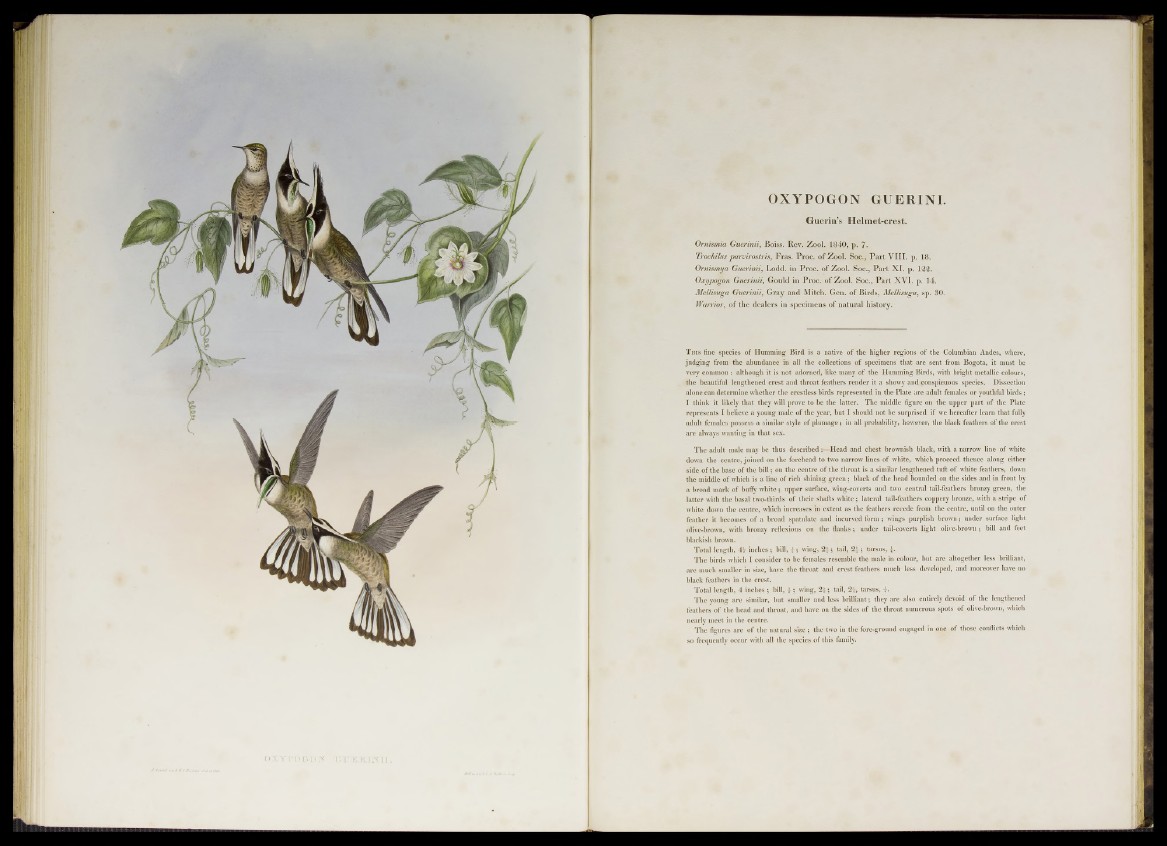
OXYPOGON GUERINI.
Guerin’s Helmet-crest.
Ornismia Guerinii, Boiss. Rev. Zool. 1840, p. 7-
Trochilus paroirostris, Fras. Proc. o f Zool. Sac., Part VIII. p. 18.
Ornismya Guerinii, Lodd. in Proc. o f Zool. Soc., Part X L p. 122.
Oxypogon Guerinii, Gould in Proc. of Zool. Soc., Part XVI. p. 14.
Mellisuga Guerinii, Gray and Mitch. Gen. of Birds, Mellisuga, sp. 30.
Warrior, o f the dealers in specimens o f natural history.
T h i s fine species o f Humming Bird is a native of the higher regions of the Columbian Andes, where,
judging from the abundance in all the collections of specimens that are sent from Bogota, it must he
very common : although it is not adorned, like many of the Hummiug Birds, with bright metallic colours,
the beautiful lengthened crest and throat feathers render it a showy and conspicuous species. Dissection
alone can determine whether the crestless birds represented in the Plate are adult females or youthful birds;
I think it likely that they will prove to be the latter. The middle figure on the upper part of the Plate
represents I believe a young male of the year, but I should not be surprised if we hereafter learn that fully
adult females possess a similar style of plumage; in all probability, however, the black feathers of the crest
are always wantiug in that sex.
The adult male may be thus described :—Head and chest brownish black, with a narrow line of white
down the centre, joined on the forehead to two narrow lines of white, which proceed thence along either
side of the base of the bill; on the centre of the throat is a similar lengthened tuft of white feathers, down
the middle of which is a line of rich shining green; black of the head bounded on the sides and in front by
a broad mark of huffy white ; upper surface, wing-coverts and two central tail-feathers bronzy green, the
latter with the basal two-thirds of their shafts white; lateral tail-feathers coppery bronze, with a stripe of
white down the centre, which increases in extent as the feathers recede from the centre, until on the outer
feather it becomes of a broad spatulate and incurved form; wings purplish brown; under surface light
olive-brown, with bronzy reflexions on the flanks; under tail-coverts light olive-brown ; bill and feet
blackish brown.
Total length, 4± inches ; bill, £; wing, ; tail, 2£; tarsus, £.
The birds which I consider to be females resemble the male in colour, but are altogether less brilliant,
are much smaller in size, have the throat and crest feathers much- less developed, and moreover have no
black feathers in the crest.
Total length, 4 inches ; bill, £ ; wing, 2 £ ; tail, 2£, tarsus, £•
The young are similar, but smaller and less brilliant; they are also entirely devoid of the lengthened
feathers of the head and throat, and have on the sides of the throat numerous spots of olive-brown, which
nearly meet in the centre.
The figures are of the natural size ; the two in the fore-ground engaged in one of those conflicts which
so frequently occur with all the species of this family.